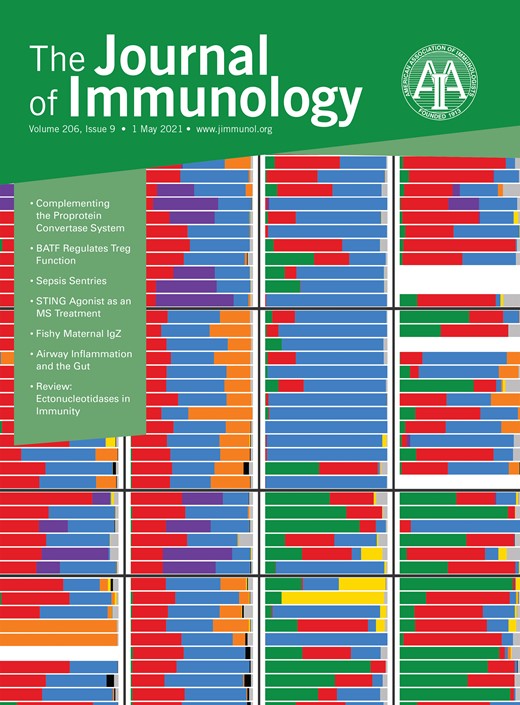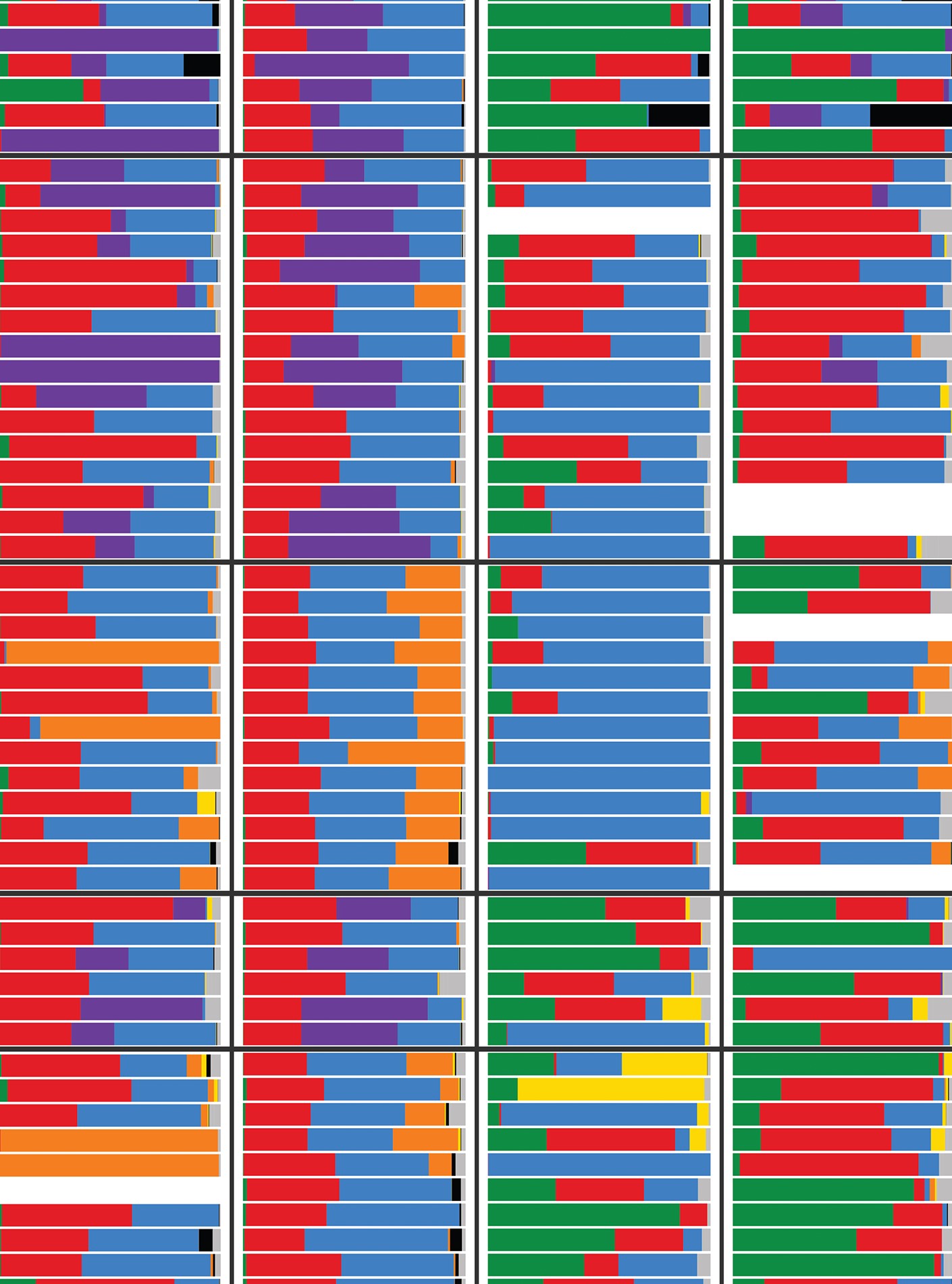
Cover image

On the cover: The plot shows changes in the taxonomical composition of the intestinal microbiota of laboratory animals (wildtype e C57BL/6 mice and transgenic V5 mice) after cohousing with feral mice. Color bars represent proportions of dominant bacterial classes in each sample. Moudra, A., V. Niederlova, J. Novotny, L. Schmiedova, J. Kubovciak, T. Matejkova, A. Drobek, M. Pribikova, R. Stopkova, D. Cizkova, A. Neuwirth, J. Michalik, K. Krizova, T. Hudcovic, M. Kolar, H. Kozakova, J. Kreisinger, P. Stopka, and O. Stepanek. 2021. Phenotypic and clonal stability of antigen-inexperienced memory-like T cells across the genetic background, hygienic status, and aging. J. Immunol. 206: 2109–2121.
Volume 206, Issue 9, May 2021
Top Reads
Top Reads
Pillars of Immunology
A Fateful Decision in the Thymus Controlled by the Transcription Factor ThPOK
Brief Reviews
Ectonucleotidases in Inflammation, Immunity, and Cancer
Allergy and other Hypersensitivities
Ovalbumin-Induced Airway Inflammation Is Ameliorated in Dectin-1–Deficient Mice, in Which Pulmonary Regulatory T Cells Are Expanded through Modification of Intestinal Commensal Bacteria
OVA-induced AAI is attenuated in Clec7a–/– mice.
Intestinal bacteria in Clec7a–/– mice can increase Treg cells in lungs.
Increased Treg cells in lungs are responsible for the suppression of AAI.
Antigen Recognition and Responses
New Insights into IgZ as a Maternal Transfer Ig Contributing to the Early Defense of Fish against Pathogen Infection
The functional role of IgZ in the maternal transfer of immunity is discovered.
Maternal IgZ contributes to the early defense of fish against pathogen infection.
Maternal IgZ in eggs can be manipulated by immunizing parent fish via vaccination.
Autoimmunity
STING Agonist Mitigates Experimental Autoimmune Encephalomyelitis by Stimulating Type I IFN–Dependent and –Independent Immune-Regulatory Pathways
cGAMP MP treatment suppressed EAE in a STING-dependent fashion via IL-27 and IL-10.
The effect was also observed in PBMCs from RRMS patients.
Conditional Deletions of Hdc Confirm Roles of Histamine in Anaphylaxis and Circadian Activity but Not in Autoimmune Encephalomyelitis
Neutrophils constitutively express the histamine-synthesizing enzyme HDC.
Regardless of its source, histamine does not contribute to EAE.
Neutrophil-derived histamine contributes to IgE-mediated anaphylaxis.
Clinical and Human Immunology
HLA Class I Polymorphisms Influencing Both Peptide Binding and KIR Interactions Are Associated with Remission among Children with Atopic Dermatitis: A Longitudinal Study
AD is a chronic waxing and waning illness.
HLA class I polymorphisms are associated with less-severe AD.
AD progression is associated with HLA polymorphisms engaging both T and NK cells.
Autoreactivity of Peripheral Helper T Cells in the Joints of Rheumatoid Arthritis
Tph cells in RA joints are equipped with Th1-like proinflammatory functions.
TCR analysis of Tph cells showed a sign of local expansion in the joint.
Tph cells exhibit autologous MLR that is regulated by PD-1.
Immune Regulation
Long Noncoding RNA RUNXOR Promotes Myeloid-Derived Suppressor Cell Expansion and Functions via Enhancing Immunosuppressive Molecule Expressions during Latent HIV Infection
RUNXOR is upregulated in PLHIV to promote MDSC expansion and suppression via RUNX1.
Overexpression of RUNXOR promotes MDSC expansion and suppressive functions.
Silencing of RUNXOR/RUNX1 attenuates MDSC expansion and suppressive functions.
Regulation of Anion Channel LRRC8 Volume-Regulated Anion Channels in Transport of 2′3′-Cyclic GMP–AMP and Cisplatin under Steady State and Inflammation
Serum protein as extracellular signal opens LRRC8/VRAC pores for cGAMP and cisplatin.
cGAS acts as an intracellular component promoting VRAC activation by serum and TNF.
Phospholipid PIP2 enriches cGAS on the plasma membrane for VRAC activation.
Metabolomic Profiles in the Intestine of Shrimp Infected by White Spot Syndrome Virus and Antiviral Function of the Metabolite Linoleic Acid in Shrimp
Seventy-eight different metabolites were identified in the intestine of WSSV-infected shrimp.
Linoleic acid directly interacts with WSSV and inhibits the viral replication.
Linoleic acid activates the ERK–NF-κB signaling pathway against WSSV in shrimp.
BATF Regulates T Regulatory Cell Functional Specification and Fitness of Triglyceride Metabolism in Restraining Allergic Responses
Mice with Treg-specific ablation of BATF develop a TH2-dominant disorder.
BATF prevents Treg cells from acquiring a TH2 cell–like phenotype.
BATF restrains triglyceride metabolism to sustain Treg suppression of TH2 responses.
Amelioration of Graft-versus-Host Disease by Exopolysaccharide from a Commensal Bacterium
EPS treatment increases survival of mice undergoing GvHD from 10 to 70%.
EPS induces inhibitory BMDCs that inhibit alloreactive T cell proliferation in MLR.
Inhibitory activity of EPS–BMDCs is mediated by IDO.
Immune System Development
Phenotypic and Clonal Stability of Antigen-Inexperienced Memory-like T Cells across the Genetic Background, Hygienic Status, and Aging
AIMT cells are steadily present in mice.
Aging, genetics, and hygienic conditions fine-tune AIMT cell numbers and phenotype.
Virtual memory T cells respond stronger to Th1 cytokines than innate memory T cells.
Immunotherapy and Vaccines
Prefusion F–Based Polyanhydride Nanovaccine Induces Both Humoral and Cell-Mediated Immunity Resulting in Long-Lasting Protection against Respiratory Syncytial Virus
RSVNanoVax induces systemic and local F-directed Ab responses.
Vaccination with RSVNanoVax induces tissue-resident memory CD4 and CD8 T cells.
Infectious Disease and Host Response
Novel Mouse Model Reveals That Serine Phosphorylation of L-Plastin Is Essential for Effective Splenic Clearance of Pneumococcus
A new mouse model was made to study the role of Ser5 phosphorylation of L-plastin.
Ser5 phosphorylation of L-plastin promoted pneumococcal bloodstream clearance.
Ser5 phosphorylation of L-plastin was needed for efficient phagocytosis.
Longitudinal Peripheral Blood Transcriptional Analysis Reveals Molecular Signatures of Disease Progression in COVID-19 Patients
SARS-CoV-2 repressed type I IFN production but induced robust ISG expression.
SARS-CoV-2 induced transient suppression of adaptive immunity.
Elevated low-density neutrophils may contribute to tissue damage in COVID-19.
IL-27/IL-27R Mediates Protective Immunity against Chlamydial Infection by Suppressing Excessive Th17 Responses and Reducing Neutrophil Inflammation
IL-27/IL-27R promotes host defense against Chlamydia muridarum respiratory infection.
IL-27/IL-27R suppresses the Th17 cell response in Chlamydia muridarum respiratory infection.
IL-27/IL-27R suppresses neutrophil infiltration in Chlamydia muridarum respiratory infection.
Kdm6b Regulates the Generation of Effector CD8+ T Cells by Inducing Chromatin Accessibility in Effector-Associated Genes
Innate Immunity and Inflammation
IFIT5 Negatively Regulates the Type I IFN Pathway by Disrupting TBK1–IKKε–IRF3 Signalosome and Degrading IRF3 and IKKε
IFIT5 functions as a negative regulator of type I IFN pathway via targeting IRF3.
IFIT5 downregulates phosphorylation of IRF3 and IKKε and blocks IRF3 translocation.
IFIT5 impairs the IRF3–TBK1–IKKε complex by degrading IRF3 and IKKε.
Proprotein Convertase Is the Highest-Level Activator of the Alternative Complement Pathway in the Blood
MASP-3 circulates mainly as an active enzyme and activates pro–factor D.
MASP-3 is activated by the proprotein convertase, PCSK6, in the blood.
Our discovery links the complement and the proprotein convertase systems.
Interplay between NOD1 and TLR4 Receptors in Macrophages: Nonsynergistic Activation of Signaling Pathways Results in Synergistic Induction of Proinflammatory Gene Expression
NOD1 and TLR4 agonists synergistically induce proinflammatory cytokine production.
Intracellular events not requiring transcription are regulated nonsynergisically.
Only a subset of M-triDAP– and LPS-inducible genes is regulated synergistically.
Molecular and Structural Immunology
The Murine MHC Class II Super Enhancer IA/IE-SE Contains a Functionally Redundant CTCF-Binding Component and a Novel Element Critical for Maximal Expression
The IA/IE-SE is critical for maximal MHC-II gene expression.
A CTCF-bound element (C15) is functionally redundant with respect to expression.
A PU.1 binding element within the IA/IE-SE is required for maximum expression.
Mucosal Immunology
Monocyte-Derived Dendritic Cells (moDCs) Differentiate into Bcl6+ Mature moDCs to Promote Cyclic di-GMP Vaccine Adjuvant–Induced Memory TH Cells in the Lung
moDCs mediate CDG-induced lung mucosal, not systematic, vaccine responses.
CDG induces a new Bcl6+ moDC population that promotes lung memory TH responses.
TNF induces the generation of lung Bcl6+ moDCs.


